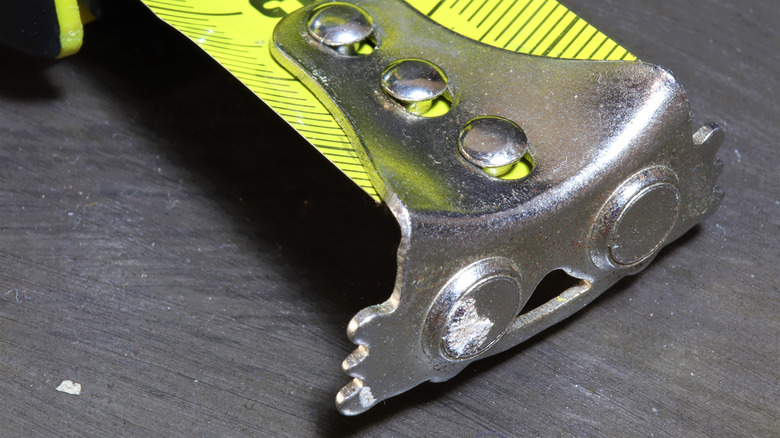The Genius Tape Measure Feature That Will Save You Frustration On Your Next DIY
Perhaps the endless slots, depressions, and cut-outs on modern power tools, which look like they might suddenly transform into galaxy-defending robots at any moment, have numbed us to the purposes of those features. (Case in point: The injection molded handle and thermoplastic over-molding on the inexpensive Ryobi screwdriver at Home Depot, which looks more like a laser weapon.) We stop thinking about it or chalk them up as decorative flourishes, and so it is that very few of us have any idea what the slot in a tape measure's hook is for. Weight or cost savings, perhaps? It turns out that the slot is an incredibly useful feature designed for nothing more complicated than hanging onto the head of a nail or screw.
Working by yourself with a tape measure of any length, you'll quickly get frustrated with trying to keep the end of the tape hooked on things like rounded wall studs. The weight of the tape is often enough to cause the hook (or its embedded magnet) to let go. A nice, long standout — the distance a measuring tape can be held out unsupported — is useful for hooking the end but doesn't do much for keeping it there. The answer is simply to drive a nail or a screw where you want the tape to end and hook the nail grab slot onto its head. It'll hold much better and give you the freedom to move around without having to be overly ginger about it.
It's stronger, more accurate, and just plain better
This little feature also introduces some flexibility and options you couldn't easily get any other way. Consider this: Hooking the tape to a board will only ever tell you how far away that end of the board is in most circumstances. Using the nail grab slot, you can connect the tape to any point where you can drive a nail or a screw. You could, for example, drive a nail in the near side of a wall stud, bend it over so the tape measure's hook reaches exactly to the edge of the stud, and measure from where you are to the near side of a board 25 feet or more away. That just won't work using magnets or standout.
Another bit of flexibility you get is the ability to connect to the nail head from many more angles than with the hook alone. This means, for example, that you can walk the tape measure in a circle around the nail, using your tape as an enormous compass to draw reasonably accurate circles twice the diameter of your tape measure's length. So, with a 25-foot tape, you can hold a pencil at the 25-foot mark and draw a 50-foot circle that's accurate to about the nail's width. That's hard to beat using something you're already carrying anyway. Now you just have to figure out what those black diamonds on tape measures mean.
